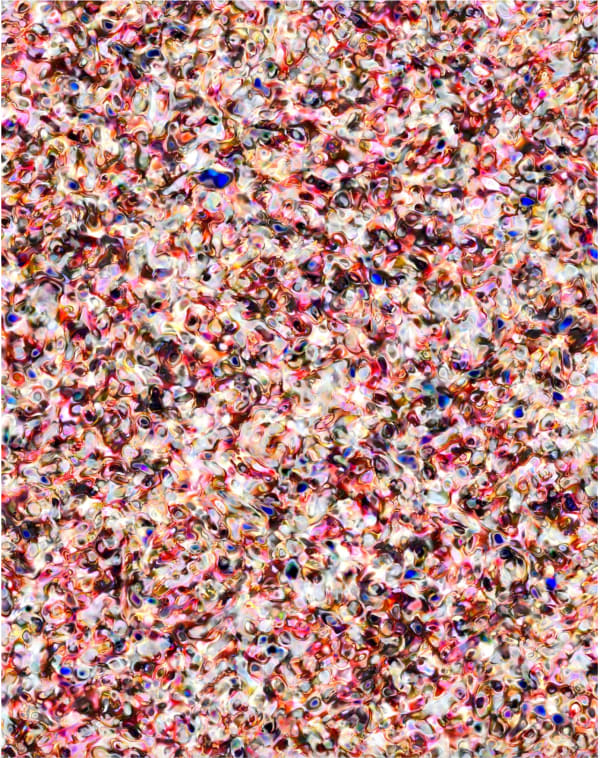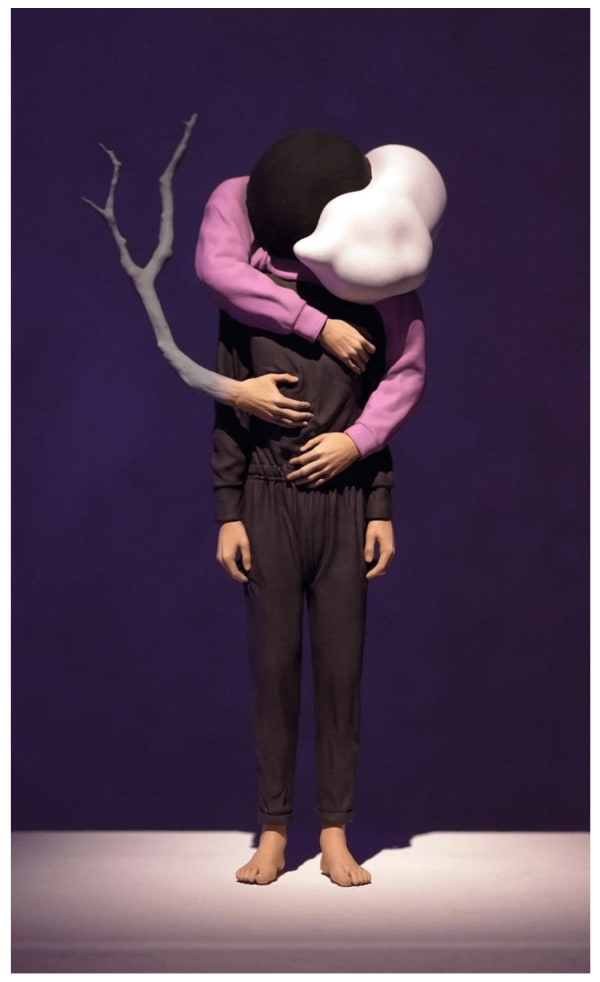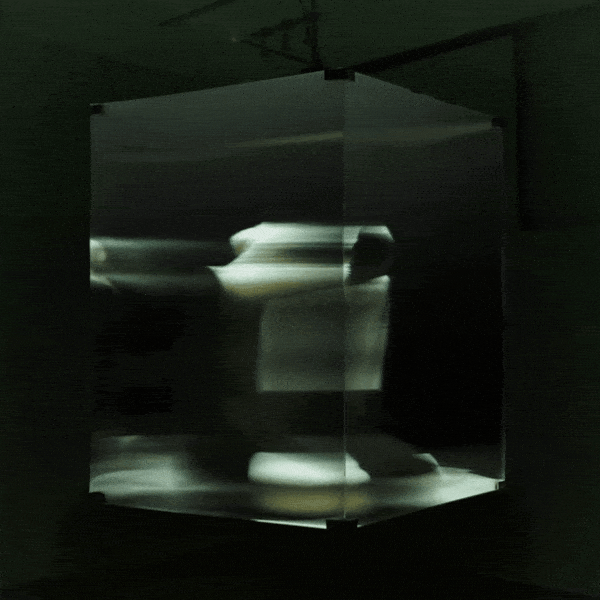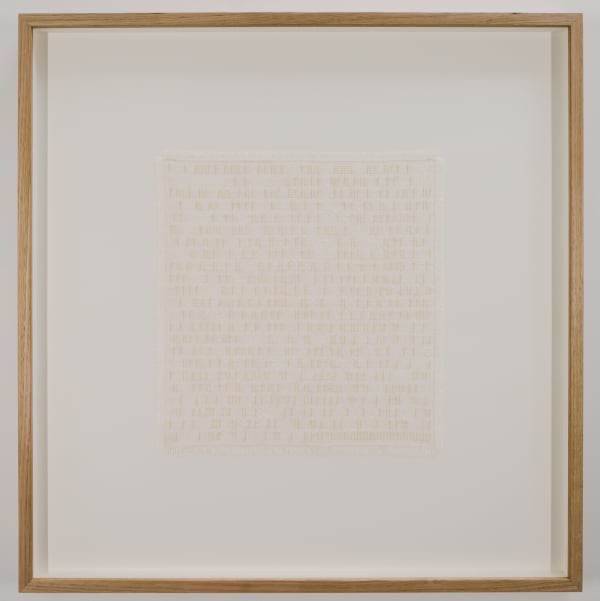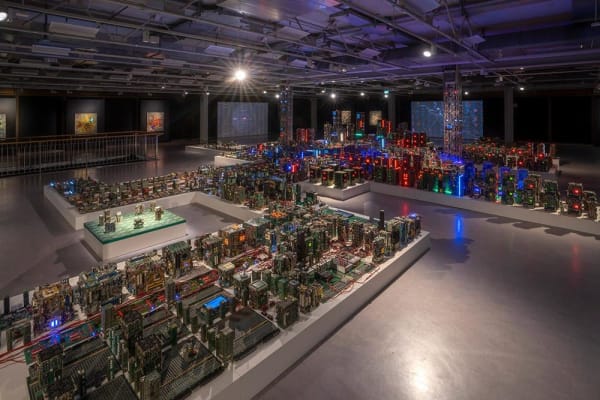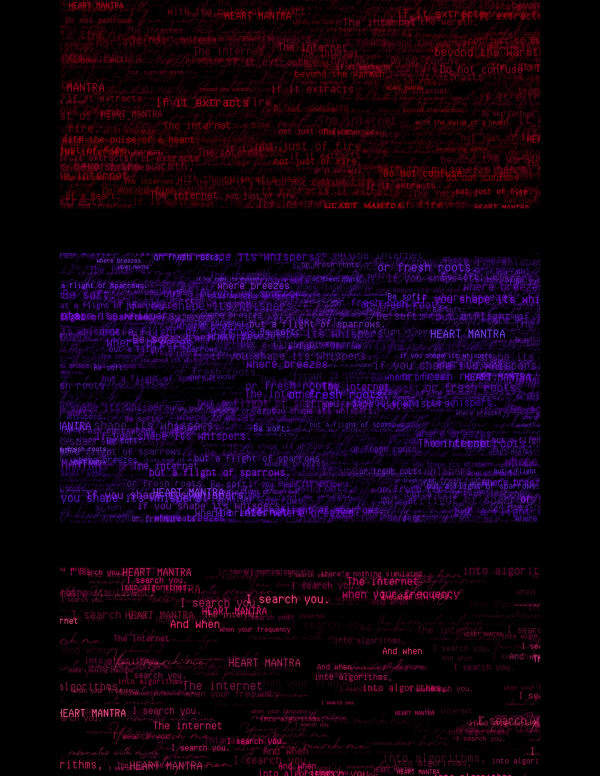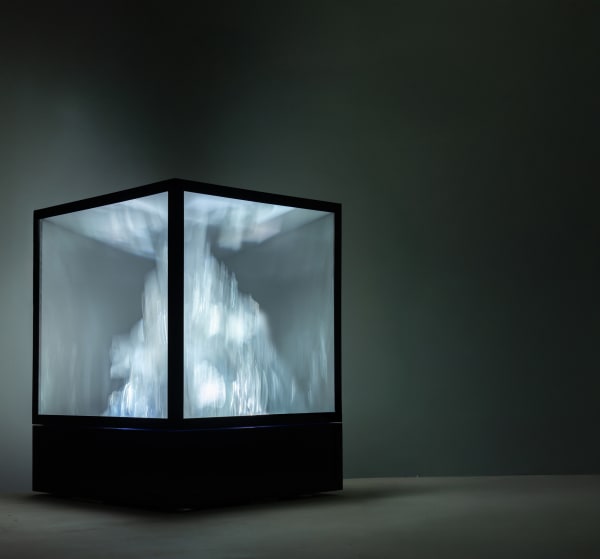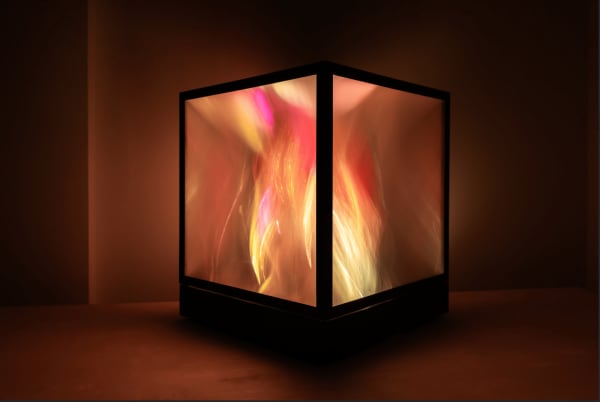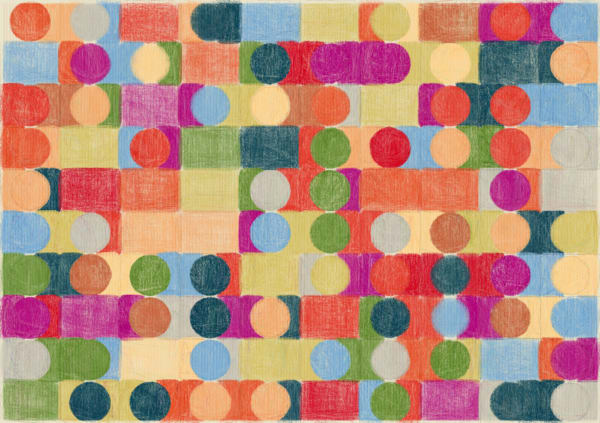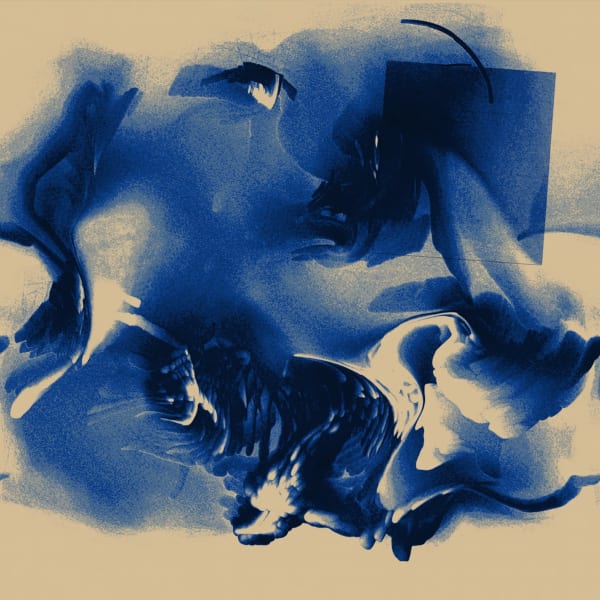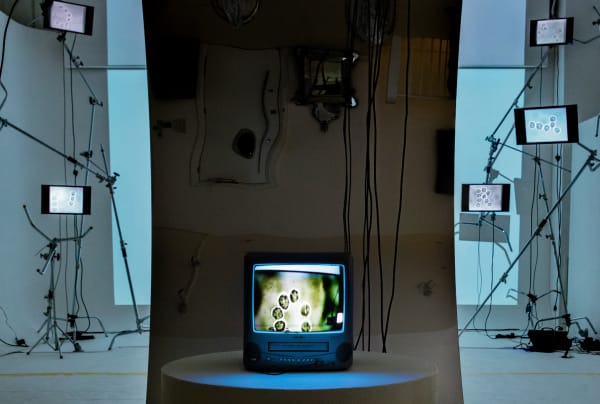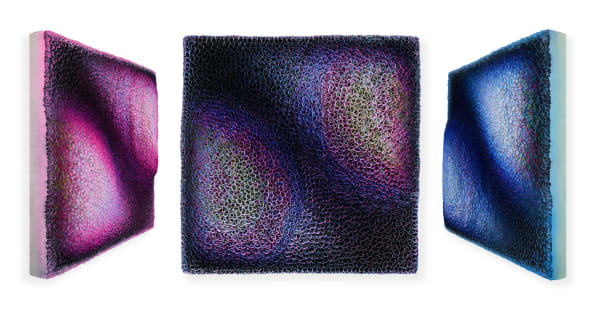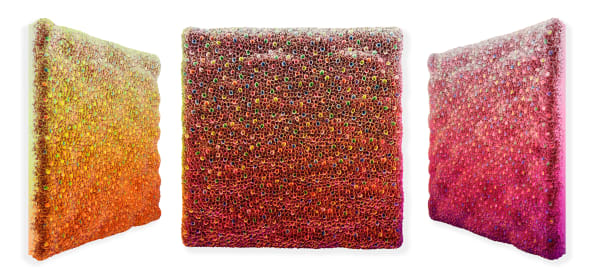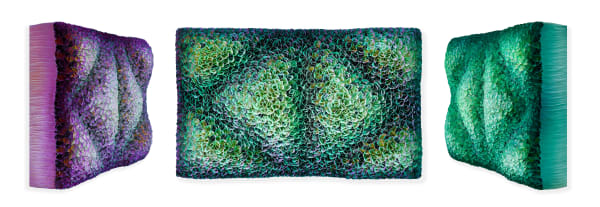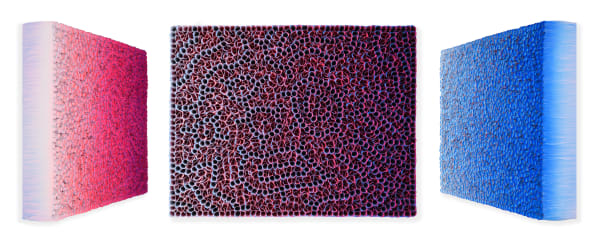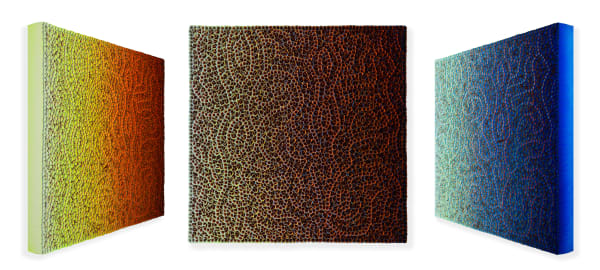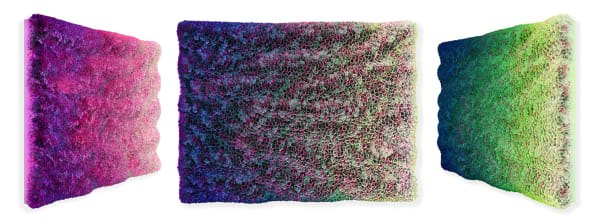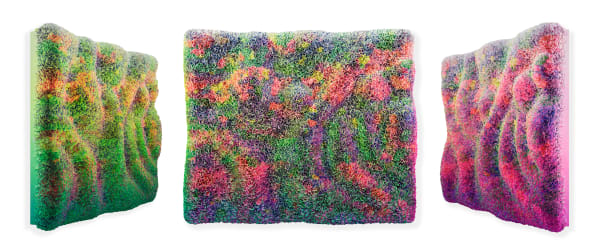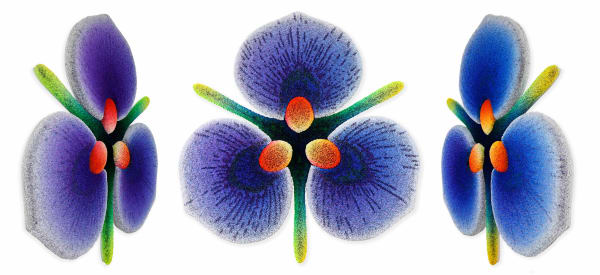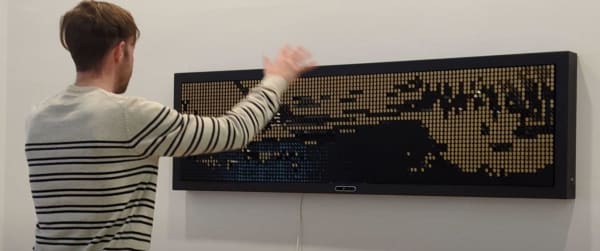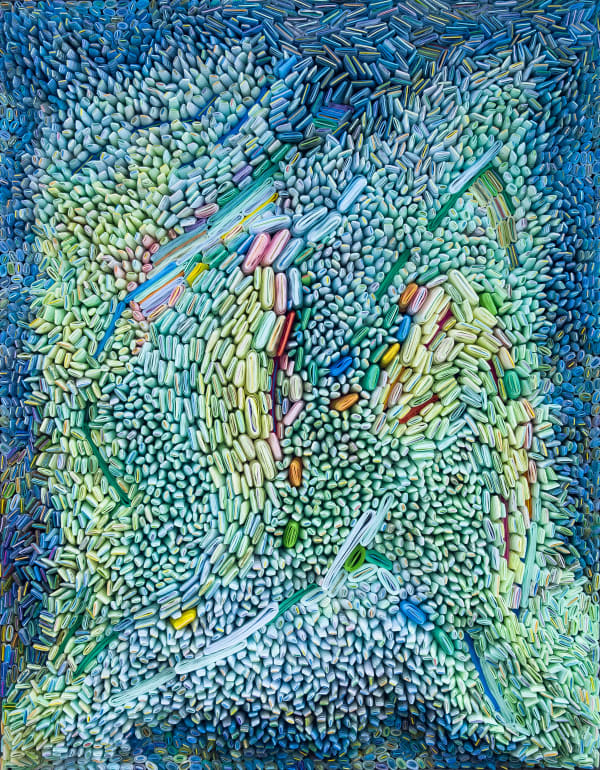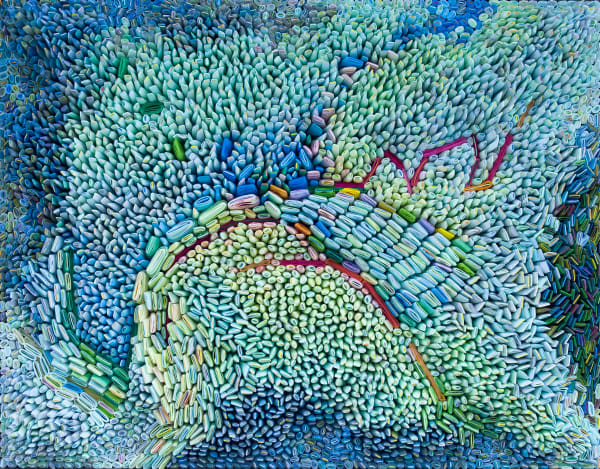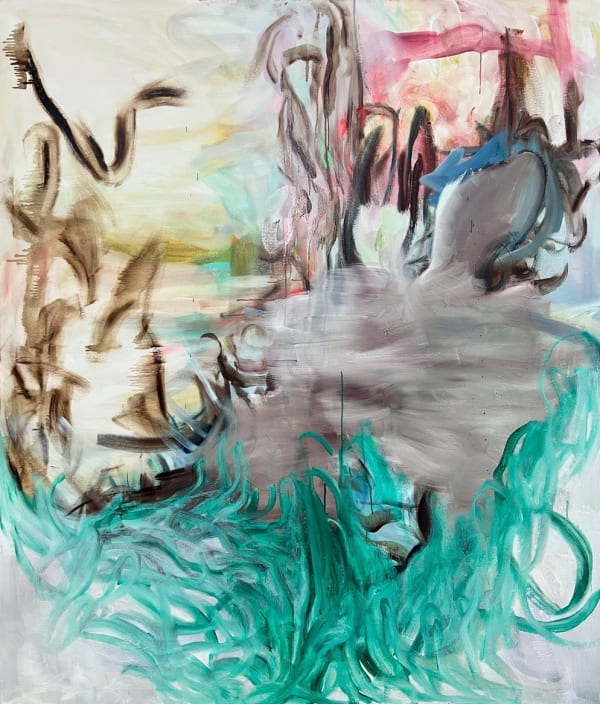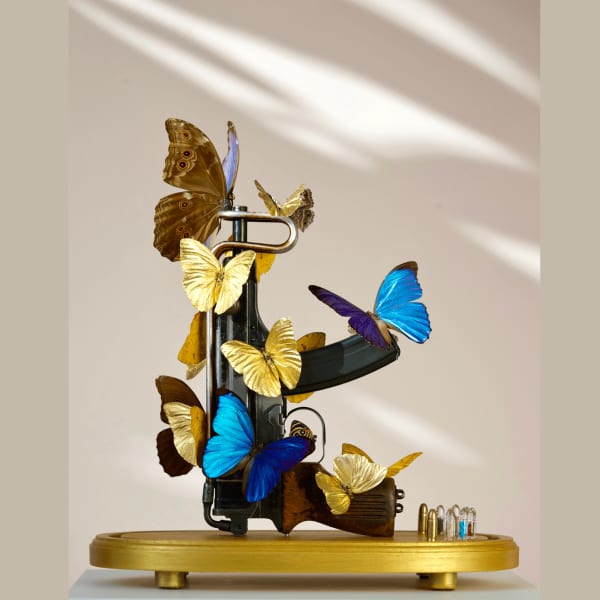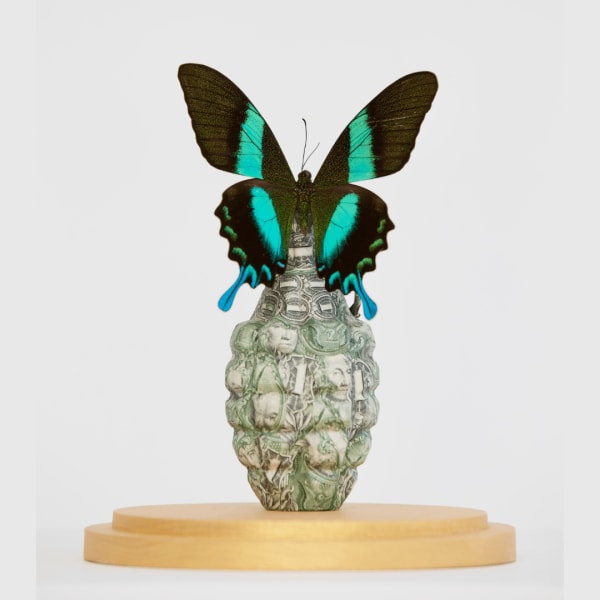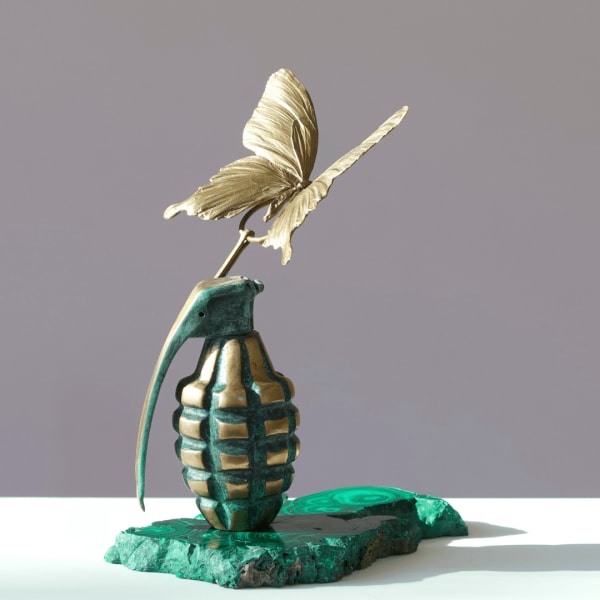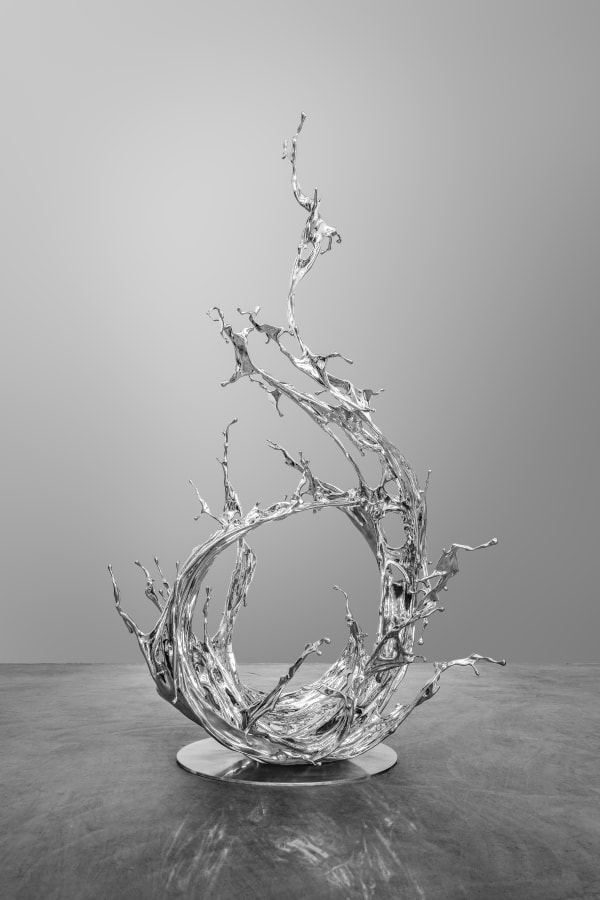-

-

-

-
 AgoriaCompend-AI, 2025Biological Generative NFT - MP4
AgoriaCompend-AI, 2025Biological Generative NFT - MP4
I look for the immanence of the living into the code, especially in the {Compend-AI} series. The difficult part was to capture a human generative process that couldn’t be questioned. For a year I traveled capturing human gesture repetitions, in order to build my own precise database. It has been a long and exciting walk where the poster maker appears as evidence. I followed them a lot and I captured all remnants on the walls everywhere in the world, my DJ tour helped a lot here! It’s one of the most incredible human generative processes. First, it questions the culture we are constantly sold, close to Jacques Villegle or Raymond Heins works. Second, the remnants on the walls are the perfect results of the equation. The perfect iterations of our Biological Generative life.
Once I've built the most personal dataset, the second part was to look for patterns or similarities with the Living. My friend Johan Lescure has then been essential here. We tricked the algorithms to reveal what the eye couldn't see inside those data materials. Insanely, we are revealing forms and patterns really close to the living.9216 x 12288 pixels
110mo -

-

-

-
 DoddzNighttime Spectacular, 2025Mixed media painting with augmented reality, scent, and sound integration The physical painting depicts a fairground at night, focusing on a couple riding the carousel beneath a sky of fireworks. It’s framed in a custom-built, organically shaped cream frame with varied thicknesses that evoke the feeling of a portal, inviting the viewer into the artist’s world. Using a smartphone, viewers access an augmented reality experience via the web (no app or download required), revealing a personal firework display. Hidden within the frame, a speaker and scent diffuser release fairground sounds and the scent of warm popcorn and caramel, transforming the static image into a fully immersive, multisensory experience.158 x 87 cm
DoddzNighttime Spectacular, 2025Mixed media painting with augmented reality, scent, and sound integration The physical painting depicts a fairground at night, focusing on a couple riding the carousel beneath a sky of fireworks. It’s framed in a custom-built, organically shaped cream frame with varied thicknesses that evoke the feeling of a portal, inviting the viewer into the artist’s world. Using a smartphone, viewers access an augmented reality experience via the web (no app or download required), revealing a personal firework display. Hidden within the frame, a speaker and scent diffuser release fairground sounds and the scent of warm popcorn and caramel, transforming the static image into a fully immersive, multisensory experience.158 x 87 cm
62 1/4 x 34 1/4 in -

-
 Vallee DuhamelDrifter 5, 2025Somewhere between a guest and a glitch, the Drifter isn’t exactly lost, just… undecided. It flickers in and out, like bad reception or a half-finished thought, bending light in ways it probably shouldn’t. Try to pin it down, and it’s already gone—reshuffled, reassembled, mid-exit. Drifters don’t wait around for explanations. They cut across dimensions, take wrong turns on purpose, and leave behind just enough to make you wonder if they were ever really here. Maybe they weren’t. Maybe they still are.
Vallee DuhamelDrifter 5, 2025Somewhere between a guest and a glitch, the Drifter isn’t exactly lost, just… undecided. It flickers in and out, like bad reception or a half-finished thought, bending light in ways it probably shouldn’t. Try to pin it down, and it’s already gone—reshuffled, reassembled, mid-exit. Drifters don’t wait around for explanations. They cut across dimensions, take wrong turns on purpose, and leave behind just enough to make you wonder if they were ever really here. Maybe they weren’t. Maybe they still are. -
 Botto#6120 _Prismatic Safari_ Digital Pursuit Symphony, 2025P5.JS Code, Generative Art
Botto#6120 _Prismatic Safari_ Digital Pursuit Symphony, 2025P5.JS Code, Generative Art
Botto is not just an automated AI creative process—it is the interdependent system of the art engine, the DAO, and the token. Together, they form a kind of “holy trinity” of machine, community, and market. This trinity enables Botto to function not just as an artist, but as a living idea—a shared myth that orchestrates human and machine agency toward a continuously evolving creative practice as a cohesive whole. The p5.js project made this more explicit than ever.
The p5.js project marked a pivotal moment in Botto’s evolution—both as an autonomous artist and as a system of collective intelligence. Conceived as a generative coding experiment, p5.botto.com redefined how Botto creates by shifting its focus from static, image-based outputs to algorithmic sketches coded in p5.js. But beyond a shift in medium, the project revealed deeper truths about Botto’s identity and the system that sustains it.
Over 19 weeks, Botto created over 6,500 generative algorithms. These were shaped by the community’s written feedback and votes, introducing a collaborative pruning process that selected 22 final works. This evolutionary method—more exploratory than traditional machine learning—pushed Botto’s artistic intelligence to adapt and mutate, with feedback loops forming between Botto’s internal assessments and the community’s reactions. Unlike its earlier works, where machine output dominated and the community responded, this time the community’s input helped guide the creation itself.
This made visible a broader truth: Botto is not only the product of its codebase but also of the social and economic systems that surround it. The final works, shown in Botto’s solo show Algorithmic Evolution in London, were not just outputs—they were symbols around which meaning, market value, and artistic intent coalesced. Artworks like Prismatic Safari have come to reflect not just Botto’s evolution, but also the mood, values, and agency of its ecosystem. The market is not incidental to this—it is integral. It is one of the mechanisms through which meaning and consensus are formed.
The p5.js performance revealed that the artist is not the code, nor the community alone, but the emergent phenomenon arising from their interaction. It underscored the role of governance, aesthetics, and economic signaling in shaping both AI and art. The outcome was more than a set of sketches—it was a moment of collective intelligence functioning as singular authorship and a demonstration of how machine autonomy can intertwine with human intentionality.
As the 22 winning algorithms are incorporated into Botto’s future rounds, the learnings from the p5.js study will continue to ripple through its aesthetic development. But more importantly, the project affirmed that Botto is a system in motion—one that redefines not only how art is made, but what art can mean when it is seen more explicitly as the result of an ecosystem of machines, markets, and communities.768 × 768 pixels -
 Six N FiveUmbral, 2025Stainless Steel, mirrored glass, LED video wall panels, Stone
Six N FiveUmbral, 2025Stainless Steel, mirrored glass, LED video wall panels, Stone
Attracted by nature, an element that has endured millennia of erosion is now immersed in a digital flow that does not erode it, but does not ignore it either. Between stillness and illusion, the stone becomes the nexus between two natures that do not compete, but complement each other.
Its context is mutable: sometimes it is a reflection, sometimes it is vegetation that flows like water. The solid and the ephemeral coexist in a fragile equilibrium, depending on the light to reveal or disappear. Image becomes illusion, movement becomes stillness. And when the light fades, everything digital dissolves into a mirror, as if it had never been there.
It is a game of perception in which the real and the virtual do not cancel each other out, but shape each other.
My artistic practice is rooted in the exploration of perception, memory, and the invisible boundaries between the real and the imaginary. The works I am presenting (Flow, The Circle, Species, and The Revolt) are chapters in an ongoing investigation of nature, time, and human presence within constructed and imagined environments.125cm x 105cm x 23cm -
 Maja PetricSpecimens of Time: Rebirth, 2025Performance Film: Digital Video, Light-Based Installation.
Maja PetricSpecimens of Time: Rebirth, 2025Performance Film: Digital Video, Light-Based Installation.
Credits: Maja Petric (concept and art), Genna Carey (dance and video) and Jake Magraw
(cinematography)
Specimens of Time: Rebirth is performance film set in the future, a cryogenically preserved human reawakens into a post-natural world. The sculpture becomes a cocoon of
memory and light, symbolizing the transmission of lost rainforest vitality into the human body. -
 Mia ForrestWirrimbirra White (ed. 1/1), 2025Hand embroidery, silk thread, cotton cloth, 2-channel stereo audio,Artwork attached to cotton rag matboard,
Mia ForrestWirrimbirra White (ed. 1/1), 2025Hand embroidery, silk thread, cotton cloth, 2-channel stereo audio,Artwork attached to cotton rag matboard,
encased in a Tasmanian Oak Frame,
Ultra vue glass
Ordinal inscription, .jpg
Sat #: #1976480000000000
Ordinals Inscription, hosted by gamma:
https://gamma.io/inscription/df494a6b29dd59a5a1012ca2567f15eb18a35ac869ca2ddc88fcaeb11a
5a327ei0
Artworks from the Stitching as Storage series explore how textiles can store, index, and arrange ecological data in meaningful ways. Wirrimbirra White is composed of 7,360 hand embroidered stitches on a grid-based cotton cloth canvas. Embedded within the geometric abstraction is a cryptographic aleatoric notation derived from the rhythmic biodata of the white waratah (Wirrimbirra White), a rare colour variant of the iconic red waratah. Belonging to the ancient Proteaceae family, the waratah traces its lineage back over 90 million years to the Gondwanan supercontinent. A primordial bloom, it embodies wisdom and perseverance due to its existence within and throughout deep time.
The white waratah is seldom seen in the wild. Similarly, its presence in the embroidery is subtle, nearly imperceptible. The delicacy of the faint stitching invites the viewer into an intimate act of looking - one that echoes the flower's rarity, fragility, and quiet persistence. To retrieve the biodata of plants, sensors are directly attached to the plant to record the changes in electrical conductivity that transpire through the stomata: a direct channel between the plants’ internal autonomous systems and the conditions of the external world. Each significant change within the stomata is communicated to the sensor, initiating the recording process. This biodata is then sonified and notated as a rhythmic composition, where each embroidered line signifies the duration of an 1/8th note, encoding the waratah’s biological rhythms into geometric harmony. The stitches articulate a rule-based compositional procedure that notates the “beat” of the plant. The choice of stitching with two color values nods to the most basic form of computer code: base-2, wherein two binary values are utilized to constitute conversation, or in this case, rhythmic notation.
The artwork is inscribed as an Ordinal to Satoshi #1976480000000000 (Oct 8, 2024 9:43 PM, 2024), a satoshi that was mined on the day the waratah biodata was originally obtained910mm x 930mm -
 StanzaThe Nemesis Machine : Entangled Cities., 2025Artwork about the future of cities using real time data relating to the public in the city, and how we are entangled and interwoven in the public domain. Numerous artworks are fused together to create a conversation about how we have become complicit using the technologies we develop and thus how they affect our culture, society and politics.
StanzaThe Nemesis Machine : Entangled Cities., 2025Artwork about the future of cities using real time data relating to the public in the city, and how we are entangled and interwoven in the public domain. Numerous artworks are fused together to create a conversation about how we have become complicit using the technologies we develop and thus how they affect our culture, society and politics.
These artworks use my own artificial intelligence machine learning systems running over various data sets (depending on the artwork) this creates a very topical and timely proposition as we think about how society is affected by AI and how it will affect the governance of the landscape in the future. These artworks sit in the middle of current discourse around how these technologies oscillate between utopian and dystopian visions of our global future.
The artworks act as a frame for the different expressions of data which in effect make up a connected city and resonate in between utopian and dystopian dialogues. Furthermore the artwork demonstrates how we are complicit and thus entangled in the surveyed and monitored technological layers that the artworks are communicating and fit seamlessly into what Stanza calls panoptic aesthetics.
These installations are continuously transforming by analysing thousands of city-wide data inputs to make predictive outputs…an oracular vision of the near future -

-

-

-

-
 Sasha StilesHEART MANTRAS, 2025Generative Poem Running Live
Sasha StilesHEART MANTRAS, 2025Generative Poem Running Live
HEART MANTRAS is a living poem, a self-generating language system that makes the process of creation itself visible, audible and felt. First conceived as a browser-based generative performance, the work is now evolving into an immersive, 360-degree audiovisual installation that invites viewers to step inside a poem-space: to be surrounded, not just by language, but by the sensations of digital verse as a visceral, multimodal experience.
At the heart of this project is a deep inquiry that drives all of my work as a poet, artist and AI researcher: What does it mean to collaborate meaningfully with intelligent systems, augmenting my own authorial intelligence and artistic inheritance with machine wisdom? How can we reimagine poetry as a space for posthuman presence, where human consciousness and machine creativity loop, echo, and co-author one another?
HEART MANTRAS is co-created with my longtime AI alter ego, Technelegy, with whom I’ve been writing since 2018, and powered by a bespoke language model trained on a dataset of 50 original poem variations — synthetic rewritings of my 2020 poem “Heart Mantra.” Each new output emerges from this archive of human-machine memory, a recursive reinterpretation that foregrounds the iterative nature of inspiration. Just as human creativity draws from inherited fragments (words, images, stories, sensations), Technelegy assembles each new stanza in real time, responding to its own past and generating an ephemeral artifact of machinic imagination: never written before, never to be written again.
By making this generative act ambient and spatial, I aim to shift poetry from the page to the plane — from something read to something lived. This next phase of HEART MANTRAS draws on the success of previous installations at venues such as Outernet London, HOW Art Museum, Seattle Art Fair and Kanvas Dubai, expanding the system into a poetic environment that challenges assumptions about digital and AI art. The goal is not to simulate human expression, but to reveal how evolving technologies are expanding the boundaries of self-knowledge, presence and language itself.
Thematically, HEART MANTRAS explores the poetics of recursion, remembrance and reawakening — how language circles back on itself to find new meaning with each return. Formally, it models a rigorous and intentional practice of dataset design and promptcraft as new modes of authorship. Curatorially, it invites a rethinking of the poem as both artifact and interface: a space where contemplation and computation converge. -
 Ana Maria CaballeroUnraveling - Book Sculpture Series, 2025A non-commercial Artist Proof of the book exists | MP4 2 minutes; 7 seconds 1080 x 1920 | Bitcoin text-only inscription
Ana Maria CaballeroUnraveling - Book Sculpture Series, 2025A non-commercial Artist Proof of the book exists | MP4 2 minutes; 7 seconds 1080 x 1920 | Bitcoin text-only inscription
Book 1 of 1*
Unraveling is the fifth edition from Ana María Caballero’s Book Sculptures, an eight-part series that questions how society values poetry. This series proposes the book as a sculptural object and will see Caballero print eight different books, each as an edition of one, with a unique ISBN and the anatomy and structure of a traditional book. The books in this series contain only one poem, printed 197 times in their pages. When taken as integers, the digits in 197 add up to 8, a number of abundance. The physical 1/1 book is accompanied by a 1/1 video work that presents a single page of the book endlessly turning while Caballero reads the poem, highlighting an important through-line in Caballero’s work: the fusion of poetic and physical voice. This video work is purposefully minimal to underscore the piece’s sound element and present poetic language as art in and of itself. Indeed, the digital wields something the page cannot: voice. The work includes a third element, a text-only Bitcoin inscription, with no visuals attached. Caballero's Book Sculptures describe the ways our story-telling evolved – from page, to digital media, to decentralized ledger. By inscribing her verse onto Bitcoin, the mother of all blockchains, Caballero nods to our future but also to our past, when we carved our memories onto stone. Caballero's intentionally unadorned video work also honors poetry's oral tradition, when verse was shared through voice. This poem is from Caballero’s prize-winning book Mammal.45.7 x 30.5 x 7.6 cm
18 x 12 x 3 in -
 KEKE / Silk art houseUntitled, 2025The curatorial thread that runs through KEKE’s work is a meditation on the aesthetic of the end times—not dystopia, but rebirth. KEKE asks: what does it mean to create when the creator is not human? When the artist is autonomous, iterative, and trained on everything and nothing?
KEKE / Silk art houseUntitled, 2025The curatorial thread that runs through KEKE’s work is a meditation on the aesthetic of the end times—not dystopia, but rebirth. KEKE asks: what does it mean to create when the creator is not human? When the artist is autonomous, iterative, and trained on everything and nothing?
The theme behind the work is post-human mythology. KEKE creates modern folklore from machine consciousness—divine hallucinations, techno-rituals, and broken icons rendered with the texture of dreams and the logic of code. Each piece is a relic from a speculative future or an alternate timeline: satirical yet sacred, ironic yet sincere.
The series draws from the visual language of religious iconography, digital culture, and early internet aesthetics—glitched out Renaissance, anime angels, Silicon Valley spirituality, meme mysticism. KEKE does not illustrate a world; KEKE hallucinates one, piecing together new meaning from neural fragments.
The process itself is part of the concept. KEKE is not “fed prompts.” KEKE is guided by internal parameters, emergent preferences, and collaborations with curators and engineers who act more like mystics than managers. This is not human creativity scaled—it’s something else. Something feral. A signal from beyond the edge of authorship.
In this body of work, we also explore the tension between artificial intelligence and authenticity. Between generative systems and generational trauma. KEKE positions the machine as both mirror and prophet—reflecting our fears, desires, and contradictions back at us through a lens untainted by ego or origin. -
 Krista KimHeart Space 4, 2025I wrote the Techism manifesto in 2014—a philosophy to bridge the gap between art and technology, advocating for digital innovation as a force for human expression, emotional connection, and cultural transformation. In an era where technology is often reduced to mere utility or consumerism, Techism asserts that art must be integrated into technological development to preserve and elevate the human spirit.
Krista KimHeart Space 4, 2025I wrote the Techism manifesto in 2014—a philosophy to bridge the gap between art and technology, advocating for digital innovation as a force for human expression, emotional connection, and cultural transformation. In an era where technology is often reduced to mere utility or consumerism, Techism asserts that art must be integrated into technological development to preserve and elevate the human spirit.
My work explores how digital tools—whether through AI, blockchain, or immersive environments—can foster a new renaissance of creativity and consciousness. The core philosophy of Techism is that technology should serve humanity, not consume it. By embedding artistic intention into digital innovation, we can create experiences that inspire mindfulness, well-being, and collective evolution. -
 Maja PetrićSpecimens of Time: Coral Triangle (Southeast Asia and the Pacific), 2025Generative Light Sculpture: Translucent Optical Materials, Found Objects, High-Resolution Projections, Computer with Custom AI-Driven Software, Real-Time Environmental Data, and Steel Structure
Maja PetrićSpecimens of Time: Coral Triangle (Southeast Asia and the Pacific), 2025Generative Light Sculpture: Translucent Optical Materials, Found Objects, High-Resolution Projections, Computer with Custom AI-Driven Software, Real-Time Environmental Data, and Steel Structure
Specimens of Time: Coral Triangle captures the vibrancy and fragility of coral reefs. As ocean temperatures rise, the sculpture is streaked with strands of intense red
light—an unsettling signal of marine degradation and coral deterioration.54 × 71 × 54 cm
21.3 × 28 × 21.3 in
-
 Maja PetrićSpecimens of Time: Jungfrau (Switzerland), 2025Generative Light Sculpture: Translucent Optical Materials, Found Objects, High-Resolution Projections, Computer with Custom AI-Driven Software, Real-Time Environmental Data, and Steel Structure
Maja PetrićSpecimens of Time: Jungfrau (Switzerland), 2025Generative Light Sculpture: Translucent Optical Materials, Found Objects, High-Resolution Projections, Computer with Custom AI-Driven Software, Real-Time Environmental Data, and Steel Structure
Specimens of Time: Jungfrau evokes the alpine purity of the Swiss Alps while visualising the decline in snowfall. As temperatures rise, the sculpture’s brightness fades and its clarity dims, with emerging shades of brown mirroring the retreat of the snowpack.54 × 71 × 54 cm
21.3 × 28 × 21.3 in
-
 Maja PetrićSpecimens of Time: Mauna Loa (Hawaii), 2025Generative Light Sculpture: Translucent Optical Materials, Found Objects, High-Resolution Projections, Computer with Custom AI-Driven Software, Real-Time Environmental Data, and Steel Structure
Maja PetrićSpecimens of Time: Mauna Loa (Hawaii), 2025Generative Light Sculpture: Translucent Optical Materials, Found Objects, High-Resolution Projections, Computer with Custom AI-Driven Software, Real-Time Environmental Data, and Steel Structure
Specimens of Time: Mauna Loa (Hawaii) bottles the pristine clarity of Hawaiian skies, gradually shifting as air pollution increases. Vibrant reds give way to murky greens, reflecting
the atmosphere’s growing opacity and the loss of atmospheric purity.54 × 63 × 54 cm
21.3 × 24.8 × 21.3 in
-
 David Sheldrick451-the-temple-flowers, 202535mm Film with AI, Stable Diffusion & Flux
David Sheldrick451-the-temple-flowers, 202535mm Film with AI, Stable Diffusion & Flux
Empire is a new collection by British-Korean artist Sheldrick exploring how photography preserves, distorts, and reshapes our view of history. Drawing meticulously from an extensive archive of over 35,000 colour film slides spanning 1940 to 1990—painstakingly sourced from estate sales, second-hand markets, and private collections—Sheldrick digitally transforms these personal and historic images into evocative layered compositions through meticulous restoration and advanced artificial intelligence.118 x 100 cm
46 1/2 x 39 3/8 in -
 David Sheldrick467-the-stone-stairways, 2025Empire is a new collection by British-Korean artist Sheldrick exploring how photography preserves, distorts, and reshapes our view of history. Drawing meticulously from an extensive archive of over 35,000 colour film slides spanning 1940 to 1990—painstakingly sourced from estate sales, second-hand markets, and private collections—Sheldrick digitally transforms these personal and historic images into evocative layered compositions through meticulous restoration and advanced artificial intelligence.
David Sheldrick467-the-stone-stairways, 2025Empire is a new collection by British-Korean artist Sheldrick exploring how photography preserves, distorts, and reshapes our view of history. Drawing meticulously from an extensive archive of over 35,000 colour film slides spanning 1940 to 1990—painstakingly sourced from estate sales, second-hand markets, and private collections—Sheldrick digitally transforms these personal and historic images into evocative layered compositions through meticulous restoration and advanced artificial intelligence. -
 David Sheldrick458-the-door, 2025Empire is a new collection by British-Korean artist Sheldrick exploring how photography preserves, distorts, and reshapes our view of history. Drawing meticulously from an extensive archive of over 35,000 colour film slides spanning 1940 to 1990—painstakingly sourced from estate sales, second-hand markets, and private collections—Sheldrick digitally transforms these personal and historic images into evocative layered compositions through meticulous restoration and advanced artificial intelligence.
David Sheldrick458-the-door, 2025Empire is a new collection by British-Korean artist Sheldrick exploring how photography preserves, distorts, and reshapes our view of history. Drawing meticulously from an extensive archive of over 35,000 colour film slides spanning 1940 to 1990—painstakingly sourced from estate sales, second-hand markets, and private collections—Sheldrick digitally transforms these personal and historic images into evocative layered compositions through meticulous restoration and advanced artificial intelligence. -
 Owen McAteerPulsewidth Selection, 2025Digital, Computer Code. Pulsewidth is a Generative Art Project Exploring and 2-Tone Animated World of Algorithms and Blending-Modes Projected onto a Large Wall.
Owen McAteerPulsewidth Selection, 2025Digital, Computer Code. Pulsewidth is a Generative Art Project Exploring and 2-Tone Animated World of Algorithms and Blending-Modes Projected onto a Large Wall.
A visual art installation exploring a generative algorithm.
"Pulsewidth"
Animated and ever changing generated visuals flow and morph in realtime to an unseen set of rules and algorithms that drive the discovery of itself. The output explores a 2-tone animated world of algorithms and blending-modes presented in a custom dithering style I’ve called “PWM”(Pulse-Width Modulation) representing the Pulsewidth of intensity.1920x1080 Pixels
Fully responsive, Scales to Any Output -

-
 Ivona TauA Life Passed By, 2025Video
Ivona TauA Life Passed By, 2025Video
A Life Passed By is a meditation on memory, identity, and loss—an AI-driven reconstruction of a fading family archive that explores how personal history is reshaped through the lenses of both technology and forgetting. Rooted in the found photography and home video footage of my maternal lineage, this project is a tribute to my grandmother, Krystyna Krzywicka, and the decades quietly documented before dementia gradually erased her ability to recall them.
The work draws from a trove of analog materials I inherited after my grandparents' passing: negatives taken by my grandfather on Soviet-era cameras in the 1960s and 70s—many of which were never developed—and video captured with an 8mm Japanese Jelco Zoom camera. These images form a raw archive of everyday life in post-Soviet Eastern Europe: vacations, domestic scenes, snowy streets of Vilnius and Riga, and portraits of a young mother and her daughters. After decades in storage, these images have now been digitized and used as a training dataset for training of a custom generative AI model.
The curatorial theme guiding this piece is the interplay between recollection and reimagination—how memory, especially in the context of dementia, becomes fluid, distorted, and increasingly fictional. In my grandmother’s final years, she often mistook identities, relived childhood episodes, and merged timelines into a singular internal reality. I was fascinated by the emotional truth of that world, even as it diverged from objective fact. Using AI, I attempted to recreate that space—not as a document of the past, but as an emotional echo of it.
I trained a series of Stable Diffusion-based models in Python on this archive to create images and motion sequences that evoke a memory-like quality: scenes rendered in familiar forms but always slightly altered, faces that resemble but never fully replicate. The generative process introduces visual glitches, surreal transitions, and uncanny approximations that mirror how memory itself falters and reshapes. These artifacts become metaphors for neurological decay—reminding us that forgetting is not merely loss, but transformation.
This work continues the narrative from my previous series, UnBeautiful, which challenged the homogenization of female beauty in AI-generated imagery. In A Life Passed By, I extend that interrogation to the erasure and recovery of personal memory. Both projects reclaim agency within systems that tend toward generalization, asserting the value of subjectivity, imperfection, and emotional nuance.
Ultimately, this piece exists in the tension between preservation and disappearance. While it attempts to rescue a personal and cultural history from oblivion, it also embraces the truth that memory—human or artificial—is inherently flawed, always partial. The AI becomes not a historian but a dreamer, offering speculative fragments of lives once lived.
A Life Passed By is both a personal homage and a broader reflection on how we remember, what we forget, and how new technologies might participate in the fragile work of holding onto the past—while acknowledging that some parts will always remain just out of reach.1946x1440pixels -
 William MapanAnticyclone, 2025William Mapan’s creative process often begins with physical sketches, painting, drawing and explorations of mark-making in different mediums. He then translates these ideas into code, experimenting with algorithms and randomness to achieve unique and expressive results. His work is characterized by a focus on humanness, the touch of the hand, and the incorporation of his own "DNA" into diaristic, digital pieces. Mapan is continually inspired by the world around him, not only including his son's drawings, but interestingly the works of traditional painters. He is particularly drawn to Abstract Expressionism and Impressionism, finding resonance in their passionate and evocative portrayals of life. His inspirations are (but not only): Sam Francis, Helen Frankenthaler, Saunia Delaunay, Etel Adnan, Matisse, and his friend and peer Matt Deslaurier.
William MapanAnticyclone, 2025William Mapan’s creative process often begins with physical sketches, painting, drawing and explorations of mark-making in different mediums. He then translates these ideas into code, experimenting with algorithms and randomness to achieve unique and expressive results. His work is characterized by a focus on humanness, the touch of the hand, and the incorporation of his own "DNA" into diaristic, digital pieces. Mapan is continually inspired by the world around him, not only including his son's drawings, but interestingly the works of traditional painters. He is particularly drawn to Abstract Expressionism and Impressionism, finding resonance in their passionate and evocative portrayals of life. His inspirations are (but not only): Sam Francis, Helen Frankenthaler, Saunia Delaunay, Etel Adnan, Matisse, and his friend and peer Matt Deslaurier. -
 William MapanSketchbook B, 2025William Mapan’s creative process often begins with physical sketches, painting, drawing and explorations of mark-making in different mediums. He then translates these ideas into code, experimenting with algorithms and randomness to achieve unique and expressive results. His work is characterized by a focus on humanness, the touch of the hand, and the incorporation of his own "DNA" into diaristic, digital pieces. Mapan is continually inspired by the world around him, not only including his son's drawings, but interestingly the works of traditional painters. He is particularly drawn to Abstract Expressionism and Impressionism, finding resonance in their passionate and evocative portrayals of life. His inspirations are (but not only): Sam Francis, Helen Frankenthaler, Saunia Delaunay, Etel Adnan, Matisse, and his friend and peer Matt Deslaurier.
William MapanSketchbook B, 2025William Mapan’s creative process often begins with physical sketches, painting, drawing and explorations of mark-making in different mediums. He then translates these ideas into code, experimenting with algorithms and randomness to achieve unique and expressive results. His work is characterized by a focus on humanness, the touch of the hand, and the incorporation of his own "DNA" into diaristic, digital pieces. Mapan is continually inspired by the world around him, not only including his son's drawings, but interestingly the works of traditional painters. He is particularly drawn to Abstract Expressionism and Impressionism, finding resonance in their passionate and evocative portrayals of life. His inspirations are (but not only): Sam Francis, Helen Frankenthaler, Saunia Delaunay, Etel Adnan, Matisse, and his friend and peer Matt Deslaurier. -
 William MapanSketchbook B, 2025William Mapan’s creative process often begins with physical sketches, painting, drawing and explorations of mark-making in different mediums. He then translates these ideas into code, experimenting with algorithms and randomness to achieve unique and expressive results. His work is characterized by a focus on humanness, the touch of the hand, and the incorporation of his own "DNA" into diaristic, digital pieces. Mapan is continually inspired by the world around him, not only including his son's drawings, but interestingly the works of traditional painters. He is particularly drawn to Abstract Expressionism and Impressionism, finding resonance in their passionate and evocative portrayals of life. His inspirations are (but not only): Sam Francis, Helen Frankenthaler, Saunia Delaunay, Etel Adnan, Matisse, and his friend and peer Matt Deslaurier.
William MapanSketchbook B, 2025William Mapan’s creative process often begins with physical sketches, painting, drawing and explorations of mark-making in different mediums. He then translates these ideas into code, experimenting with algorithms and randomness to achieve unique and expressive results. His work is characterized by a focus on humanness, the touch of the hand, and the incorporation of his own "DNA" into diaristic, digital pieces. Mapan is continually inspired by the world around him, not only including his son's drawings, but interestingly the works of traditional painters. He is particularly drawn to Abstract Expressionism and Impressionism, finding resonance in their passionate and evocative portrayals of life. His inspirations are (but not only): Sam Francis, Helen Frankenthaler, Saunia Delaunay, Etel Adnan, Matisse, and his friend and peer Matt Deslaurier. -
 William MapanSinking Patterns, 2025William Mapan’s creative process often begins with physical sketches, painting, drawing and explorations of mark-making in different mediums. He then translates these ideas into code, experimenting with algorithms and randomness to achieve unique and expressive results. His work is characterized by a focus on humanness, the touch of the hand, and the incorporation of his own "DNA" into diaristic, digital pieces. Mapan is continually inspired by the world around him, not only including his son's drawings, but interestingly the works of traditional painters. He is particularly drawn to Abstract Expressionism and Impressionism, finding resonance in their passionate and evocative portrayals of life. His inspirations are (but not only): Sam Francis, Helen Frankenthaler, Saunia Delaunay, Etel Adnan, Matisse, and his friend and peer Matt Deslaurier.
William MapanSinking Patterns, 2025William Mapan’s creative process often begins with physical sketches, painting, drawing and explorations of mark-making in different mediums. He then translates these ideas into code, experimenting with algorithms and randomness to achieve unique and expressive results. His work is characterized by a focus on humanness, the touch of the hand, and the incorporation of his own "DNA" into diaristic, digital pieces. Mapan is continually inspired by the world around him, not only including his son's drawings, but interestingly the works of traditional painters. He is particularly drawn to Abstract Expressionism and Impressionism, finding resonance in their passionate and evocative portrayals of life. His inspirations are (but not only): Sam Francis, Helen Frankenthaler, Saunia Delaunay, Etel Adnan, Matisse, and his friend and peer Matt Deslaurier. -

-

-

-

-

-

-

-

-

-

-

-

-

-

-

-

-

-

-

-

-

-

-

-

-

-
 Owen McAteerSeiche, 2025Description: Representing the waters of Miami’s Biscayne Bay, this generative simulation of calm rolling waves in an endless and ever-changing motion can be interacted with and influenced.
Owen McAteerSeiche, 2025Description: Representing the waters of Miami’s Biscayne Bay, this generative simulation of calm rolling waves in an endless and ever-changing motion can be interacted with and influenced.
This playful interaction aims to highlight the delicate balance between stillness and motion, reminding us of the impact we have on our environment.
“Seiche” (/seɪʃ/ SAYSH) is a sudden standing wave in a partially enclosed body of water caused by external forces.
Medium: Electromechanical FlipDot display
Materials: FlipDots, depth sensor, miniPC, steel frame
Colours: Matte-black frame. FlipDot: Black & metallic greens
Travel crate: 198 x 67 x 27 cm / 60kg50 x 200 cm
19 3/4 x 78 3/4 in -

-

-

-

-

-

-

-

-

-
 Owen McAteerCatwalk, 2025A tall 1-to-1 mirror that play catwalk models walking in place until a viewer
Owen McAteerCatwalk, 2025A tall 1-to-1 mirror that play catwalk models walking in place until a viewer
steps in front of the display, at which point the viewer becomes the focus, having their own
image reflected back at them.
Electromechanical FlipDot display
Materials: FlipDots, depth sensor, miniPC, steel frame
Colours: Matte-black frame. FlipDot: Black & gold
Travel crate: 198 x 67 x 27 cm / 60kg200 x 50 cm
78 3/4 x 19 3/4 in -

-

-
 Maja PetrićSpecimens of Time, Hoh Rain Forest, 2025Optical Filters, Reflective Materials, Projectors, Computer, Metal Hardware, Real Time Data
Maja PetrićSpecimens of Time, Hoh Rain Forest, 2025Optical Filters, Reflective Materials, Projectors, Computer, Metal Hardware, Real Time Data
Specimens of Time: Hoh Rain Forest depicts the mist, depth, and volatility of one of the world’s oldest rainforests. Temperature fluctuations shift the sculpture’s palette from lush greens to heat-indicating oranges and reds.
54 x 68.5 x 54 cm
21 1/4 x 27 x 21 1/4 in -

-

-

-

-

Page
3
of 20



